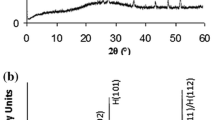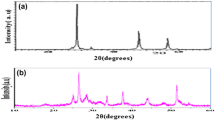Abstract
The effects of incorporation of aluminum and chlorine simultaneously into buffer solution grown cadmium sulphide thin films (i.e. dual impurity doping), on the electrical and optical properties of the films for various concentrations of aluminum and chlorine in the range 0.0002–0.01 wt % have been investigated. The results showed that the thicknesses (and optical absorption) of aluminum doped CdS films increased slightly as the aluminum concentration was increased, leading to decrease in optical transmittance and bandgap energy, and improvement of the dark electrical conductivity of the films. For aluminum concentrations of 0.01 wt % and above, the electrical conductivity of the doped CdS films was impaired. The dark electrical conductivity of aluminum-doped CdS films is at least ten times that of pure Cds film and at least one hundred times in the presence of chlorine. Generally, in the presence of chlorine, the electrical conductivity and the optical transmittance of the aluminum-doped CdS films were improved to some extent for aluminum concentrations ≤0.001 wt %. Optical bandgap varies from 2.45 eV for pure CdS film to 2.30–2.35 eV for doped films. The possible mechanisms for these observed effects are discussed. © 2000 Kluwer Academic Publishers
Similar content being viewed by others
References
T. L. Chu and S. S. Chu, Solid-State Electron. 38 (1995) 533.
A. G. Stanley in, ``CdS Solar Cells Applied Solid State Sciences. Vol. 5'', (Academic Press, New York, 1975) p. 251.
R. Jayakrishnan, J. P. Nair, B. A. Kuruvilla, S. K. Kulkarni and R. K. Pandey, J. Mater. Sci. Mater.in Electron. 7 (1996) 193.
M. S. Tomar and F. J. Garcia, Prog. Cryst. Growth 4 (1981) 221.
F. V. Shallcross, RCA Rev. 28 (1967) 569.
N. Nakayana, Jpn. J. Appl. Phys. 8 (1969) 450.
A. G. Shikalgar and S. H. Pawar, Thin Solid Films 61 (1979) 313.
S. Jatar, A. C. Rastogi and V. G. Bhide, Pramana 16 (1978) 477.
D. K. Pandya and K. L. Chopra, in ``Vacuum surfaces-Thin films'', (Vanity Books, Delhi, India, 1981) p. 258.
A. E. Vanaerschot, J. J. Capart, K. H. David, M. F. Fabhricotti, K. H. Heffels, J. J. Loferski and K. K. Reinhartz, in ``Solar Cells'', (IEEE Press, New York, 1976) 239.
R. H. Bube and S. M. Thomson, J. Chem. Phys. 23 (1955) 15.
F. A. Kroeger, H. J. Vink and J. Van Den Boomgaard, Z. Phys. Chem. 203 (1954) 1.
S. Bhushan, B. Diptithankur, J. Mater. Sci: Mater. in Electron. 3 (1992) 35.
J. Lambert, A. Holderness and F. S. Taylor, in ``Essentials of Volumetric Analysis,'' (Heinemann Educational Books Ltd, London, 1968).
C. D. Lokhande and S. H. Pawar, Solid State Commun. 44 (1982) 1137.
C. F. Liptrot ``Modern Inorganic Chemistry'' (English Language Book Society, Mills and Boon Limited 1974) 209.
N. G. Dhere, D. L. Waterhouse, K. B. Sundaram, O. Melendez, N. R. Parikh and B. Patmaik, J. Mater Sci.: Mater. Electron. 6 (1995) 52.
S. Gorer and G. Hodes J. Phys. Chem. 98 (1994) 5338.
M. N. Islam and M. O. Hakim, J. Mater. Sci. Lett. 4 (1985) 1125.
H. Neumann, B. Perit, N. A. K. Abdul-Hussein and R. D. Tomlinson, Cryst. Res. Technol. 17 (1982) 469.
E. Fatas, P. Herrasti, K. Arjona, G. Camarero and J. A. Medina, Electrochim Acta 32 (1987) 139.
S. Raghunath Reddy and A. K. Mallik, Thin Solid Films 143 (1986) 113.
Author information
Authors and Affiliations
Rights and permissions
About this article
Cite this article
Akintunde, J.A. Dual impurity doping of buffer solution grown cadmium sulphide thin films: electrical and optical properties. Journal of Materials Science: Materials in Electronics 11, 503–508 (2000). https://doi.org/10.1023/A:1008920602583
Issue Date:
DOI: https://doi.org/10.1023/A:1008920602583




